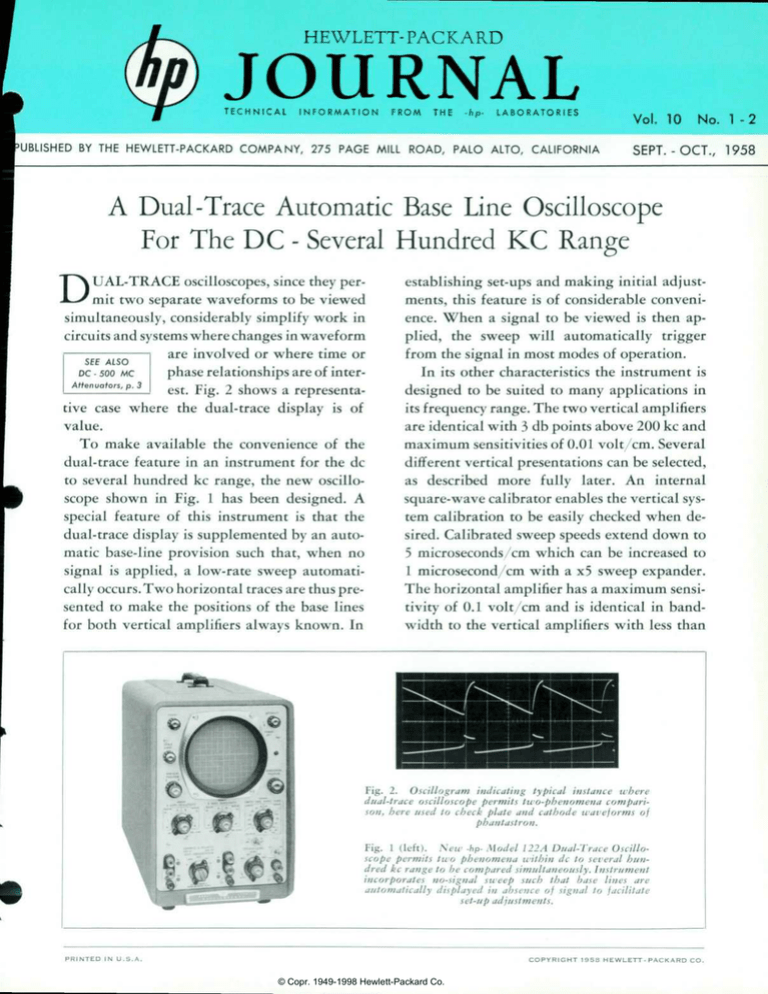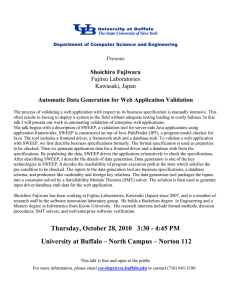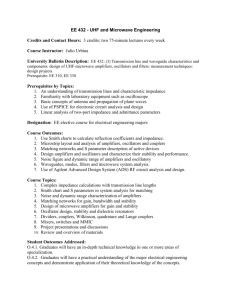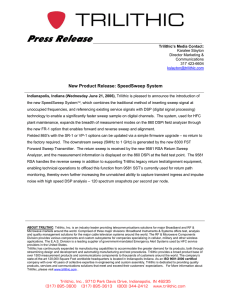JOURNAL HEWLETT-PACKARD
advertisement

HEWLETT-PACKARD
JOURNAL
T E C H N I C A L
I N F O R M A T I O N
F R O M
T H E
- h p -
L A B O R A T O R I E S
/ol. 10 No. 1-2
HJBLISHED BY THE HEWLETT-PACKARD COMPANY, 275 PAGE MILL ROAD, PALO ALTO, CALIFORNIA
SEPT. -OCT., 1958
A Dual -Trace Automatic Base Line Oscilloscope
For The DC - Several Hundred KC Range
DUAL-TRACE oscilloscopes, since they per
mit two separate waveforms to be viewed
simultaneously, considerably simplify work in
circuits and systems where changes in waveform
are involved or where time or
phase relationships are of inter
est. Fig. 2 shows a representa
tive case where the dual-trace display is of
value.
To make available the convenience of the
dual-trace feature in an instrument for the dc
to several hundred kc range, the new oscillo
scope shown in Fig. 1 has been designed. A
special feature of this instrument is that the
dual-trace display is supplemented by an auto
matic base-line provision such that, when no
signal is applied, a low-rate sweep automati
cally occurs. Two horizontal traces are thus pre
sented to make the positions of the base lines
for both vertical amplifiers always known. In
establishing set-ups and making initial adjust
ments, this feature is of considerable conveni
ence. When a signal to be viewed is then ap
plied, the sweep will automatically trigger
from the signal in most modes of operation.
In its other characteristics the instrument is
designed to be suited to many applications in
its frequency range. The two vertical amplifiers
are identical with 3 db points above 200 kc and
maximum sensitivities of 0.01 volt/cm. Several
different vertical presentations can be selected,
as described more fully later. An internal
square- wave calibrator enables the vertical sys
tem calibration to be easily checked when de
sired. Calibrated sweep speeds extend down to
5 microseconds /cm which can be increased to
1 microsecond cm with a x 5 sweep expander.
The horizontal amplifier has a maximum sensi
tivity of 0.1 volt/cm and is identical in band
width to the vertical amplifiers with less than
Fig. 2. Oscillogram indicating typical instance where
dual-trace oscilloscope permits two-phenomena compari
son, here used to check plate and cathode waveforms of
phantastron,
Fig. 1 (left). New -hp- Model 122 A Dual-Trace Oscillo
scope permits two phenomena within dc to several hun
dred kc range to be compared simultaneously. Instrument
incorporates no-signal sweep such that base lines are
automatically displayed in absence of signal to facilitate
set-up adjustments.
P R I N T E D
I N
U . S . A .
C O P Y R I G H T
© Copr. 1949-1998 Hewlett-Packard Co.
1 9 5 8
H E W L E T T - P A C K A R D
C O .
CHANNEL A POLARITY
P O S .
U P
N E C
U P
VERT. PRESENTATION
C H O P
fi-A
a  »
A L T .
w e-* usr CHjutaa. 9
vLn«ies MO rosins* CONTROL
Fig. 3. Vertical presentation selector pro
vides for five types of vertical display.
Concentric switch inverts A channel sig
nal to facilitate two-signal comparison.
±2° differential phase shift at 100 kc.
If desired, differential phase shift at a
higher frequency can be minimized
with an internal adjustment.
VERTICAL PRESENTATIONS
The oscilloscope is designed with a
five-position vertical presentation se
lector (Fig. 3) to permit an optimum
display to be selected for a given appli
cation. The extreme selector positions
(A and B) provide for single-channel
presentations, while the intermediate
positions present combinations of the
two vertical channels, with CHOP and
ALT being the dual-trace displays in
which the two inputs can be viewed
simultaneously. In the CHOP position,
the vertical deflection system is elec
tronically switched between the two
vertical amplifiers at a 40 kc rate for
such purposes as permitting a compari
son of single transients and generally
facilitating comparison of lower fre
quency signals. If desired, however,
chopped operation can be used to view
higher-frequency signals as well, al
though in the rather remote event that
the signal is harmonically-related at a
low ratio to the 40 kc chopping fre
quency, the detail of the presentation
will be diminished, since the chopping
frequency will be "stopped." Alternate
sweeping can then be used. For chopped
operation an external trigger is required
to prevent the trigger system from
synchronizing on the chopping wave
form.
NONHARMONICALLY-RELATED
WAVEFORMS
In the ALT position the sweep alter
nately presents the outputs of the two
vertical amplifiers. This mode is a gen
eral-purpose mode for dual-trace pre
sentations at sweep speeds faster than
about 10 milliseconds/cm with a PI
phosphor tube. Besides its general-Pur-
Fig. 4. Typical bandwidth
characteristic of Model
1 22 A. Curve applies to all
three amplifiers. Differen
tial phase shift between
amplifiers is less than
±2° at 100 kc.
pose nature, however, this position has
the special advantage, which is a basic
advantage for the dual-trace type of
two-channel instrument, that it per
mits nonharmonically-related signals to
be viewed. This occurs because the trig
ger system can alternately trigger from
the two amplifier outputs. The feature
is thus useful for such purposes as com
paring time markers with non-inte
grally-related waves where only alter
nate triggering will "stop" both wave
forms. Where the relative phases of
harmonically-related waveforms are of
interest, however, an external trigger
should be used with alternate operation.
Dual-trace displays are additionally
facilitated by an in verting switch which
is concentric with the vertical presenta
tion selector. This switch changes the
polarity of the "A" channel presenta
tion to accommodate phase reversals be
tween different pick-off points in the
source.
Fig. 5. Rack-mounting version has been
designed with panel height of 7 inches for
economy of rack space.
DIFFERENTIAL PRESENTATION
The B - A position presents the in
stantaneous difference between the sig
nal voltages applied to the A and B
terminals and is thus specifically suited
to viewing signals in differential or
balanced sources. The position is also
convenient for mixing two harmoni
cally-related signals of widely different
amplitudes. Common mode voltages on
the differential signal are suppressed by
at least 3 0 db in the B - A position.
Differential inputs are also provided
on the most sensitive position of each
vertical amplifier. Common mode volt
ages on the applied signal will be sup
pressed in the most sensitive position
bv at least 40 db.
© Copr. 1949-1998 Hewlett-Packard Co.
5% 10%
F R E O
50KC IOOKC
E H C Y
\ 40
2 3 500 KC
VERTICAL AND
HORIZONTAL RESPONSES
The two vertical amplifiers are de
signed to be identical and all three
amplifiers in the instrument are designed
to have the same bandwidth (Fig. 4)
and phase characteristics. Although the
high-frequency 3 db point for the am
plifiers is rated at 200 kc, it is usually
about 40% above this. At the same time
roll-off is slow so that the oscilloscope
is usable at frequencies considerably
above the 3 db point. The trigger sys
tem will usually respond to frequencies
well above 500 kc to permit viewing
of higher frequency signals.
The differential phase shift between
the three amplifiers is less than 2° at
100 kc. The A vertical amplifier and
the horizontal amplifier include a phaseadjusting capacitor so that relative
phase shift can be minimized at a
higher frequency if desired.
TRIGGER SYSTEM
As mentioned earlier, the trigger sys
tem is designed so that in the absence
of a signal a low repetition rate sweep
occurs to enable the operator to know
the position of the base line. If the in
strument is set for dual-trace opera
tion, a base line is shown for each am
plifier. When a signal is applied, the
sweep will automatically trigger from
the signal for all but chopped presenta
tions, which require the use of an ex
ternal trigger signal. If desired, the
point on the signal at which the sweep
triggers can be selected over a range
from —10 to +10 volts with the Trig
ger Level control. This control can also
be used to disable the automatic base
line sweep when desired.
For cases where it is desired to ex
amine a portion of a display in more
detail, the sweep can be expanded 5
times with a switch on the panel. The
operation is such that the center 2 cm
of the screen is expanded to full screen
width, while any 2 cm portion of the
unexpanded sweep can be selected for
expansion with the horizontal position
ing control.
The sweep expansion feature can also
be used to increase the fastest sweep of
(Concluded on p. 4)
TWO HIGH-PERFORMANCE ATTENUATORS
FOR THE DC - 500 MC RANGE
A TTENUATORS for use in the re-tX gion between the ultrasonic range
and waveguide frequencies have, in
general, had one or more of several dis
advantages such as being non-adjust
able, having only a limited attenua
tion range, being non-direct reading,
or, in the case of the cutoff type,
having a high insertion loss. To over
come these disadvantages, two new 50ohm variable attenuators have been de
signed to provide a total of 132 db of
Fig. 1. As a pair, new -dp- Models 355A/B
50-obm Attenuators provide from 0 to
132 db of attenuation in I db steps over
dc to 500 me frequency range.
attenuation in 1 db steps over the fre
quency range from dc to 500 mega
cycles. One attenuator provides from 0
to 120 db in 10 db steps, while the
second provides from 0 to 12 db in 1
db steps. Each attenuator has been de
signed with a single direct-reading con
trol both to achieve simplicity of use
for typical bench work as well as to
permit the attenuators to be incorpo
rated easily into panel or console in
stallations. For such installations it is
feasible to mount the attenuators in
electrically convenient locations within
an equipment bay and either to provide
rigid or flexible shafts to operate them
from the panel (Fig. 2) or to remotely
operate them with suitable stepping
mechanisms. The units are also de
signed with a small cross section so
that, in permanent installation applica
tions, they can easily be mounted di
rectly behind a panel as well.
CONSTRUCTION TECHNIQUE
The basic approach in the design of
the attenuators has been to extend the
response of conventional lumped-ele
ment configurations to a high fre
quency by closely controlling stray
parameters. Both attenuators consist of
a series of pi pads which are connected
in cascade to permit a matched 50-ohm
input and output impedance to be
achieved at all attenuation levels. In
high-frequency attenuators of this type
it is necessary to locate the pad switches
physically very close to the individual
pads, but in order to avoid the need for
manually operating a multiplicity of
switches and to achieve the remote con
trol feature described above a design
has been evolved that operates the in
dividual switches from a single shaft.
This shaft mounts four cams which
operate small sensitive-type switches.
These in turn connect the appropriate
pads in or out of the network as the
control knob is rotated. Since the at
tenuator is designed as a cascade rather
than a ladder type, any combination of
pads can be switched in this manner
without altering the 50-ohm input or
output impedance.
Each attenuator consists of four
pads. In the 120 db unit these have
values of 10, 20, 30 and 60 db. In the
12 db unit the values are 1, 2, 3 and 6
db. The pads are con
structed with precision
carbon film resistors for
a frequency response well 5; §
beyond 500 me. Such a ^-j*
range is possible when care
is taken with lead induetances and where capacities are closely controlled. §§
In the design stage each
of the pads was considered
separately and its per
formance optimized as an
individual network. By
mounting the resistors and
switches on a suitable
aluminum block, it was
possible to control resistor
lead length and capacity
to ground as well as to
achieve repeatability of
these factors in produc
tion units. The impedance
of the individual sections
was then checked and ad
justed to 500 me with
the -hp- Model 8 03 A VHP
Impedance Bridge'. In the
120 db unit the result of
^-ATTENUATOR
KNOBS AND DIALS
Fig. 2. Single-shaft operation permits
attenuators to be mounted in suitable lo
cation within racks and operated from
panel with flexible shafts or stepping
mechanisms.
these measures was that the response of
the 10 db pad was down 1 db at 1700
me, the 20 db pad at 1100 me, and the
30 db pad at 700 me. Two of the 30 db
pads were then cascaded to form the
60 db pad. In the 0 to 12 db unit the
responses were comparable or wider be
cause of the smaller resistance values.
Isolation between each pad input and
¡^
-0.2
'.IRC 25 I'KC
aArchur Fong, "Direct Measure
ment of Impedance in ihe 50-500
MC Range," Hewlett-Packard
Journal, Volume 1, No. 8,
April, 1950.
© Copr. 1949-1998 Hewlett-Packard Co.
IOKC 100 KC
FREQU
-V 335 B
VHF ATTENUATOR
IMC
ENCY
IOHC IOOHC
UG-49IA/U
INPUT
OR
OUTPUT
OUTPUT
OR
INPUT
Fig. 4. Overall dimensions of -hp- 355 A/B.
Adapter noted can be used for intercon
nection. Solid-shielded cable assemblies
are also available.
output is achieved by symmetrically
disposing each pad into two compart
ments of a cast aluminum box. Connec
tions between pads are constructed as
5 0-ohm lines. A number of designs were
tried for these lines, but the simplest
and most controllable was found to be
a straight bare wire placed next to a
movable ground plane and insulated
therefrom by an insulating tape film.
The arrangement is such that the sepa
DUAL-TRACE SCOPE
('Continued from p. 2)
the instrument from 5 /¿sec/cm to 1
¿isec/cm.
GENERAL
To insure stability, the low-level ver
tical amplifier stages are operated with
SPECIFICATIONS
-hpMODEL 122A
DUAL TRACE OSCILLOSCOPE
SWEEP
Sweep Range: 15 Calibrated sweeps, accurate
to within ±5%, in a 1, 2, 5, 10, ... se
quence, 5 /¿sec/cm to 200 millisec/cm. Ver
nier permits continuous adjustment of sweep
time between calibrated steps and extends
the 200 millisec/cm step to at least 0.5
sec /cm.
Sweep Expand: X5 sweep expansion may be
used on all ranges and expands fastest
sweep to 1 ¿¿sec cm. Expansion is about the
center of the CRT and expanded sweep ac
curacy is ±10%.
Synchronizai/on: Internally from vertical de
flection signals causing 12 cm or more ver
tical deflection, from line voltage, and from
external signals 2.5 volts peak-to-peak or
greater.
Trigger Point: Automatic. Control overrides
automatic and permits the trigger point to
be set between — 10 and —10 volfs. Turn
ing fully counter-clockwise into AUTO re
stores auïomatic operation.
VERTICAL AMPLIFIERS
BandW/dfh: Dc coupled: dc to 200 kc.
Ac coupled: 2 cps to 200 kc.
Bandwidth is independent of calibrated sen
sitivity setting.
Sensifivify; 10 millivolts cm to 100 volts/cm.
4 calibrated steps accurate within ±5%, 10
mv/cm, 100 mv cm, 1 v/cm and 10 v/cm.
Vernier permits continuous adjustment of
sensitivity between steps and extends 10
v cm step to at least 100 v/cm.
ration of wire and ground plane can be
adjusted after assembly to refine the
line impedance to the required degree.
The operation of the integrated unit
was then checked against a standard
cutoff type attenuator.
These measures have resulted in the
performance indicated in Fig. Ã- which
represent the tolerances established for
production units. The characteristics
are not controlled above 500 me, but
the units are ordinarily useful to much
higher frequencies for simple level-set
ting and similar usage where step ac
curacy is not a factor. Transient re
sponse has also been checked with
pulses of a few millimicroseconds' rise
time without discernible waveshape
change.
SPECIAL MOUNTING
CONSIDERATIONS
To facilitate side-by-side mounting
of the attenuators, the terminals are
physically located in complementary
positions, as shown in Fig. 4. Any series
arrangement can be used for connecting
the terminals and any terminal can be
used for input or output, but the ar
rangement indicated in Fig. 4 is con
venient in that it permits a type UG49 1 A/U adapter to interconnect the at
some 150 volts of common mode de
generation and with regulated tube
heaters. Transistors are used as the con
trol elements in the heater regulator.
The main rectifier circuit for the in
strument uses silicon rectifiers for long
life and low heat dissipation.
Internal Calibrator: Calibrating signal auto
matically connected to vertical amplifier for
standardizing of gain, accuracy ±2%.
Input Impedance: 1 megohm, less than 70 fifif
shunt capacitance.
Pfiase Sniff: Vertical and horizontal amplifiers
have same phase characteristics within ±2°
to 100 kc when verniers are fully cw.
Balanced Input: On 10 mv/cm range on both
amplifiers. Input impedance, 2 megohms
shunted by less than 35 ¿Ã-¿¿f. Common mode
rejection is at least 40 db. Common mode
signal must not exceed ±3 volts peak.
Difference Input: Both input signals may be
switched to one channel to give differential
input on all vertical sensitivity ranges. The
sensitivity switches may be set separately
to allow mixing signals of different levels.
Common mode rejection is at least 40 db
with both switches on most sensitive range,
30 db on other ranges.
HORIZONTAL AMPLIFIER
Bandwidth; Dc coupled: dc to 200 kc.
Ac coupled: 2 cps to 200 kc.
Bandwidth is independent of calibrated sen
sitivity setting.
Sensitivity.- 0.1 volt/cm to 100 volts/cm. 3
calibrated steps, accurate within ±5%, .1
v/cm, 1 v/cm, and 10 v/cm. Vernier permits
continuous adjustment of sensitivity between
steps and extends 10 v/cm step to at least
100 v cm.
input impedance: 1 megohm, nominal, shunted
by less than 120 fifif.
Prices f.o.b. Palo Alto, California
Data subject to change without notice
© Copr. 1949-1998 Hewlett-Packard Co.
tenuators. For input and output cables,
the wide range of attenuation of the
units makes it necessary to use doubleshielded cable such as RG-5 J/U. Special
solid-shielded cable assemblies are also
available to provide a still higher mea
sure of shielding.
—Arthur Fong and Harley L. Malversan
SPECIFICATIONS
-hp- MODELS 355A/B
ATTENUATORS
ATTENUATION: -hp- 355A, 12 db in 1 db steps;
-hp- 355B, 120 db in 10 db steps.
FREQUENCY RANGE: DC to 500 me.
OVERALL ACCURACY: -hp- 355A, ±0.25 db, dc
to 500 me; -hp- 355B, ±1 db, dc to 250 me,
±2 db, 250 to 500 me.
NOMINAL IMPEDANCE: 50 ohms.
MAXIMUM SWR: 1.2 to 250 me, 1.5 to 500 me.
MAXIMUM INSERTION LOSS: 0 at de, 0.4 db at
60 me, 1 db at 250 me, 1.5 db at 500 me.
POWER DISSIPATION: 0.5 watt average; 350
volts peak.
CONNECTORS: Female type BNC.
WEIGHT: 1V2 Ibs. net; shipping weight 3 Ibs.
PRICE: -hp- Model 355A Attenuator, $125.00.
-hp- Model 355B Attenuator, $125.00.
ACCESSORIES AVAILABLE: 803A-16E solid
shield 50-ohm Cable Assembly, 15 inches
long with male BNC connectors, $9.00.
803A-16D RG-55/U Cable Assembly, 2 feet
long, terminated by a male type N connector
on one end and a male BNC connector on the
other. $8.50.
Prices f.o.b. Palo Alto, California
Data subject to change without notice
A rack-mounting version of the in
strument (Fig. 5) has been designed
with minimal panel height (7 inches)
to conserve rack panel area.
Other characteristics of the instru
ment are given in the accompanying
specifications. -John Strathman
GENERAL
Cathode Ray Tube: 5AQPI mono-accelerator
normally supplied; 2500 volt accelerating
potential. P7 and Pll phosphors are also
available. P2 ¡s available if desired for
special applications.
CRT Bezel: Light proof bezel provides firm
mount for oscilloscope camera and is re
moved easily for quick change of filter.
CRT Plates-. Direct connection to deflection
plates via terminals on rear. Sensitivity ap
proximately 20 v/cm.
Intensity Modulated: Terminals on rear. - 20 v
to blank trace of normal intensity.
Filter Supplied: Color of filter compatible with
CRT phosphor supplied.
Illuminated Graticule: Edge lighted with con
trolled illumination, 10 cm x 10 cm, marked
in cm squares. Major horizontal and vertical
axes have 2 mm subdivisions.
Dimensions: Cabinet Mount: 934" wide, 15"
high, 21 1/4" deep.
Rack Mount: 19" wide, 7" high, 2114" deep.
19V2" deep behind panel.
Weight: Cabinet Mount: Net 35 Ibs., shipping
51 Ibs.
Rack Mount: Net 33 Ibs., shipping 48 Ibs.
Power.- 115 230 volts ±10%, 50-1000 cps; ap
proximately 150 watts.
Accessories Available: AC-83A Viewing Hood,
face-fitting molded rubber, Price: $4.50.
Price: Model 122A Cabinet Mount: S625.00.
Model 122AR Rack Mount: $625.00.
Normally supplied with PI phosphor. When
ordering P2*, P7 or Pll, specify by adding
phosphor number after model.
*P2 is not recommended for general purpose
usage.




